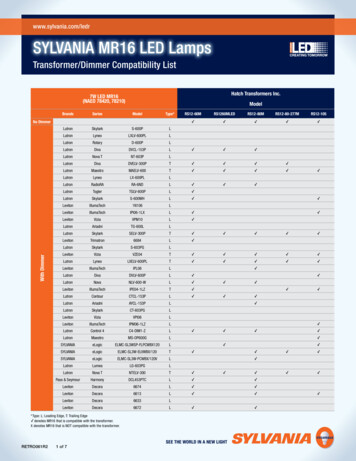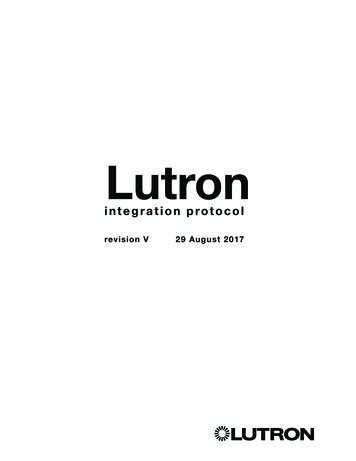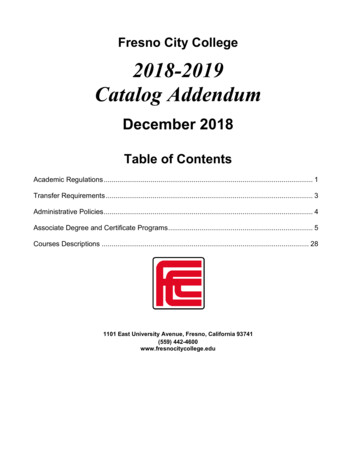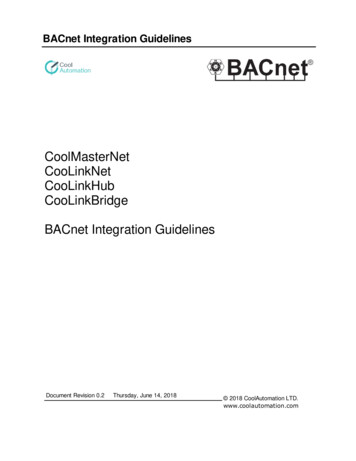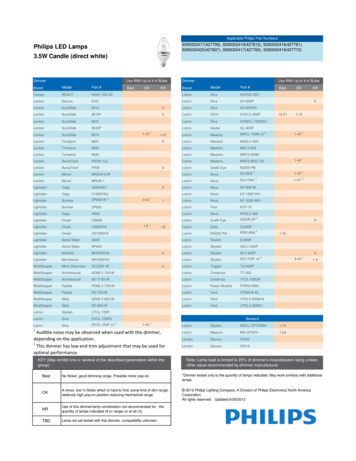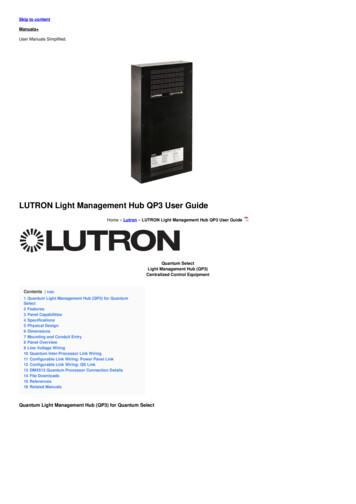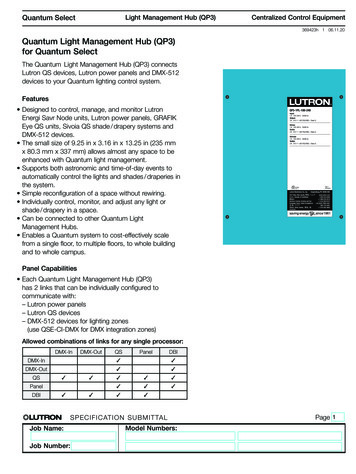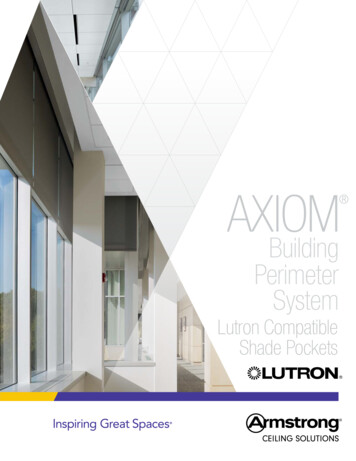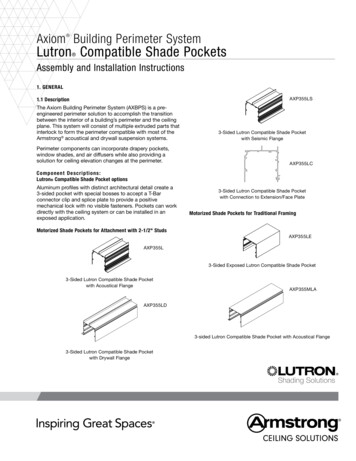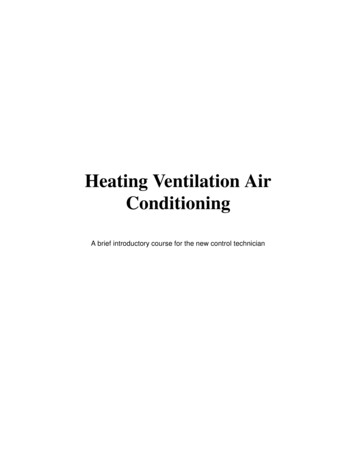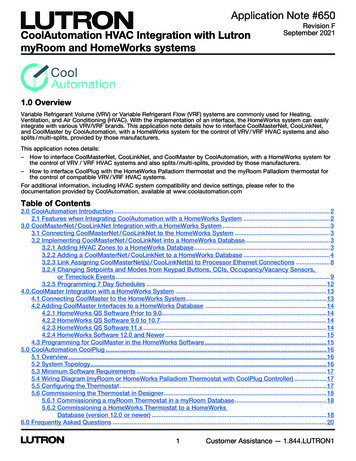
Transcription
Application Note #650CoolAutomation HVAC Integration with LutronmyRoom and HomeWorks systemsRevision FSeptember 20211.0 OverviewVariable Refrigerant Volume (VRV) or Variable Refrigerant Flow (VRF) systems are commonly used for Heating,Ventilation, and Air Conditioning (HVAC). With the implementation of an interface, the HomeWorks system can easilyintegrate with various VRV/VRF brands. This application note details how to interface CoolMasterNet, CooLinkNet,and CoolMaster by CoolAutomation, with a HomeWorks system for the control of VRV / VRF HVAC systems and alsosplits / multi-splits, provided by those manufacturers.This application notes details:– How to interface CoolMasterNet, CooLinkNet, and CoolMaster by CoolAutomation, with a HomeWorks system forthe control of VRV / VRF HVAC systems and also splits / multi-splits, provided by those manufacturers.– How to interface CoolPlug with the HomeWorks Palladiom thermostat and the myRoom Palladiom thermostat forthe control of compatible VRV / VRF HVAC systems.For additional information, including HVAC system compatibility and device settings, please refer to thedocumentation provided by CoolAutomation, available at www.coolautomation.comTable of Contents2.0 CoolAutomation Introduction.22.1 Features when Integrating CoolAutomation with a HomeWorks System.23.0 CoolMasterNet / CooLinkNet Integration with a HomeWorks System.33.1 Connecting CoolMasterNet / CooLinkNet to the HomeWorks System.33.2 Implementing CoolMasterNet / CooLinkNet into a HomeWorks Database.33.2.1 Adding HVAC Zones to a HomeWorks Database.33.2.2 Adding a CoolMasterNet / CooLinkNet to a HomeWorks Database.43.2.3 Link Assigning CoolMasterNet(s) / CooLinkNet(s) to Processor Ethernet Connections.83.2.4 Changing Setpoints and Modes from Keypad Buttons, CCIs, Occupancy/Vacancy Sensors,or Timeclock Events.93.2.5 Programming 7 Day Schedules.124.0. CoolMaster Integration with a HomeWorks System.134.1 Connecting CoolMaster to the HomeWorks System.134.2 Adding CoolMaster Interfaces to a HomeWorks Database .144.2.1 HomeWorks QS Software Prior to 9.0.144.2.2 HomeWorks QS Software 9.0 to 10.7.144.2.3 HomeWorks QS Software 11.x.144.2.4 HomeWorks Software 12.0 and Newer.154.3 Programming for CoolMaster in the HomeWorks Software.155.0 CoolAutomation CoolPlug.165.1 Overview.165.2 System Topology.165.3 Minimum Software Requirements.175.4 Wiring Diagram (myRoom or HomeWorks Palladiom Thermostat with CoolPlug Controller).175.5 Configuring the Thermostat.175.6 Commissioning the Thermostat in Designer.185.6.1 Commissioning a myRoom Thermostat in a myRoom Database.185.6.2 Commissioning a HomeWorks Thermostat to a HomeWorksDatabase (version 12.0 or newer).186.0 Frequently Asked Questions.201Customer Assistance — 1.844.LUTRON1
Application Note #6502.0 CoolAutomation IntroductionLutron has collaborated with CoolAutomation to offer a series of HVAC interfaces, in the CoolMasterNet, CooLinkNet,and CoolMaster product families, for the control of VRV / VRF systems. These product families include interfaces forthe control of a wide variety of VRV / VRF, split, and multi-split equipment from many different manufacturers.2.1 Features when Integrating CoolAutomation with a HomeWorks SystemCoolMaster IntegrationControls and TriggersOperating Mode ControlAdvanced ProgrammingCoolAutomation Specific1Supported?Palladiom ThermostatYesControl from a keypadYesOccupancy/Vacancy SensorsYesTimeclockYesLutron Connect (HomeWorks QS)YesLutron App (HomeWorks QSX)No1HeatYesCoolYesAutoYesFanYesOffYesGreen ModeNoConditional Logic based onCoolMaster settingsYesDry ModeYesSwing StatusNoFilter SignNoMalfunction CodeNoReset FilterNoSwing On/OffNoHomeWorks QSX systems will support app control of HVAC zones in Q1 2022.2www.lutron.com/support
Application Note #6503.0 CoolMasterNet / CooLinkNet Integration with a HomeWorks SystemThe CoolMasterNet allows for the control of VRV / VRF HVAC systems from 3rd party and mobile applications. TheCooLinkNet allows for the control of split, and multi-split HVAC systems from 3rd party and mobile applications. Bothinterfaces connect directly to the local area network (LAN) within the residence allowing for direct integration with theHomeWorks system without the need for a protocol converter.NOTE: Use the latest version of CoolMasterNet / CooLinkNet firmware when integrating with a HomeWorks system.For instructions on upgrading firmware, please refer to the CoolAutomation website at www.coolautomation.com3.1 Connecting CoolMasterNet / CooLinkNet to the HomeWorks SystemWi-Fi / Wired RouterEthernetFD/ColRJ45Con/ActRJ45FD/Col2 1P250 mACooLinkNetMUXCCICOMMUXCOMMUXL2: 24 V- 1.0 A4,4 in-lb0,5 N mLED DEL DMUXDV COMMUXMUXV COMQS L2PWRERRPPL1L1 TX /RXL2L2 TX /RXV COM 44.(0)20.7680.44811 2 3 4 524-36 V- 250 mA SELV NEC Class 2lutron.com 1.844.LUTRON1 44.(0)20.7702.0657L1: 24 V- 1.0 A1.844.LUTRON1V ORHQP7-2MUXwww.lutron.com/qsQS L10,28 in7 mmHomeWorks QSX ProcessorIEC PELV / SELV / NECR Class 2lutron.comCOM24 – 36 V- 250 mAV L1HQP6-2L2HomeWorks QSMUXL1L25 4 32.0 A / L1, L224 – 36 V-PWRCon/ActEthernetCOMCoolMasterNet1 2 3 4 5EthernetHomeWorks QSProcessorHomeWorks QSX ProcessorThe CoolMasterNet / CooLinkNet interfaces must all be connected to the same LAN that the HomeWorksprocessor(s) reside(s) on.3.2 Implementing CoolMasterNet / CooLinkNet into a HomeWorks Database3.2.1 Adding HVAC Zones to a HomeWorks DatabaseTo add a 3rd Party HVAC zone to the database, go to the design tab of the Lutron Designer software and use thedrop-down menu to select loads. Next, find the HVAC Zones tab on the right hand side of the screen.Click on Add load at the bottom of the screen.Continued on next page.3Customer Assistance — 1.844.LUTRON1
Application Note #6503.0 CoolMasterNet / CooLinkNet Integration with a HomeWorks System (continued)3.2 Implementing CoolMasterNet / CooLinkNet into a HomeWorks Database (continued)3.2.1 Adding HVAC Zones to a HomeWorks Database (continued)For each HVAC zone added, provide a Zone Name, select Operating Modes, and select the Fan Speeds thatare applicable to the zone being created. Unchecked modes will be hidden when using the Lutron mobile app. It isimportant to check only the modes that are necessary so the app is simpler for the end user. Choosing a user friendlyzone name is important for the same reason.UID reflects the indoor unit address. All indoor units have to be given addresses (depending on specific HVAC systemtype, this can be done automatically by system, or has to be done manually by integrator). Addresses should be setby an HVAC contractor and the integrator should acquire the addresses from the contractor. The UID must be 3 digitslong, no letters, spaces, or punctuation characters, and follow a specific numbering series.If integrating with a CoolMasterNet, the CoolMasterNet display will auto-detect and update with all indoor units asshown in the example image below. The display shows them in the format Ln.ABC where “n” is the line number ofCoolMasterNet and ABC is the UID address. The UIDs in this example are 101, 102, 104 connected to the Link L1 of theCoolMasterNet.In this example, the CoolMasterNet auto-detected L2.101 zone connected to L2 of CoolMasterNet.Note: Having two separate zones with the same UID (L1.101 and L2.101 as shown in image below) is not allowed and theHVAC contractor would need to change the L2.101 to any other address that does not conflict with existing UIDs.3.2.2 Adding a CoolMasterNet / CooLinkNet to a HomeWorks DatabaseTo add CoolAutomation equipment to the database, go to the design tab of the software and use the drop-down menuto select equipment. Next, find the 3rd Party HVAC device in the toolbox and click on the plus sign to add the device.NOTE: the default toolbox does not contain this device by default, so it is necessary to edit or create a toolbox toinclude the 3rd Party HVAC device.Continued on next page.4www.lutron.com/support
Application Note #6503.0 CoolMasterNet / CooLinkNet Integration with a HomeWorks System (continued)3.2 Implementing CoolMasterNet / CooLinkNet into a HomeWorks Database (continued)3.2.2 Adding a CoolMasterNet / CooLinkNet to a HomeWorks Database (continued)Once the 3rd Party HVAC control has been added to the Equipment Locations area, provide a name for the HVACcontrol and select CoolAutomation as the Manufacturer.Once the manufacturer selection is made, choose the appropriate Model for the CoolAutomation equipment:– CoolMasterNET (0.5 C / 1 F Precision)– CoolMasterNET (1 C / 1 F Precision)NOTE: For CoolPlug interface, refer to Section 4.0.0 and for CoolMaster interface, refer to Section 5.0.0Next, Assign HVAC zones using the Output tab. One CoolMasterNet can control multiple zones (maximum quantitydepends on the manufacturer of the HVAC system). Up to 64 HVAC zones can be assigned to a single Ethernet link.Each CooLinkNet can only control a single zone – do not assign multiple zones to the 3rd Party HVAC interface ifusing the CooLinkNet.NOTE: When adding the 3rd Party HVAC interface, a zone is automatically added by default. All zones should be createdas seen in the previous section, so this auto-created zone can be deleted.Continued on next page.5Customer Assistance — 1.844.LUTRON1
Application Note #6503.0 CoolMasterNet / CooLinkNet Integration with a HomeWorks System (continued)3.2 Implementing CoolMasterNet / CooLinkNet into a HomeWorks Database (continued)3.2.2 Adding a CoolMasterNet / CooLinkNet to a HomeWorks Database (continued)The final step is to assign any remote Lutron temperature controls that will be used to also control the setpoints andmodes. There are two options for remote temperature controls:Palladiom ThermostatThe Palladiom thermostat is a QS wired link device which can act as a remote thermostat control for CoolAutomation.It takes one address of the 99 available on a QS link and there can be up to 32 Palladiom thermostats per QS linkmaximum. When using a Palladiom thermostat with CoolAutomation equipment, the sensor within the Palladiomthermostat is not used by the system. The Palladiom thermostat can be activated in 11.5 or newer versions of thesoftware. Note that for systems using QSX processors, a software version of 21.4 or newer is required when integratingwith CoolAutomation.The Palladiom thermostat can be added to the project by navigating to Design Controls and selecting the desireditem from the toolbox. If the items do not show in the default Temperature tab, they can be added by clickingEdit Toolbox.Select the correct device location from the area tree, hover over the control, and then click the “ ” sign to add thecontrol to the area.Continued on next page.6www.lutron.com/support
Application Note #6503.0 CoolMasterNet / CooLinkNet Integration with a HomeWorks System (continued)3.2 Implementing CoolMasterNet / CooLinkNet into a HomeWorks Database (continued)3.2.2 Adding a CoolMasterNet / CooLinkNet to a HomeWorks Database (continued)Click on Assign. under the Assigned Devices field.Then click on Assign on the Palladiom thermostat that will control the zone.The name of the remote temperature control will now be visible in the Assigned Devices field.The CoolMasterNet / CooLinkNet has a built-in ethernet port and connects directly to the network without the needfor a converter. CoolMasterNet / CooLinkNet is set to DHCP and will automatically receive an IP address once it isconnected to a Local Area Network (LAN) with a DHCP server. The IP address will be seen in the lower right cornerof the CoolMasterNet screen and in the upper right corner of the CooLinkNet screen. It is recommended to set aStatic IP address for the CoolMasterNet / CooLinkNet. Type this IP address into the Controller Settings tab for theCoolMasterNet / CooLinkNet. The port number will be 10102 and no username or password is required.Below is a depiction of the controller settings when using a CoolMasterNet / CooLinkNet interface.For more information on the setup of the CoolMasterNet, CooLinkNet, or setting fixed IP addresses on CoolAutomationdevices, refer to the Programmer Reference Manuals from CoolAutomation, available on www.coolautomation.comContinued on next page.7Customer Assistance — 1.844.LUTRON1
Application Note #6503.0 CoolMasterNet / CooLinkNet Integration with a HomeWorks System (continued)3.2 Implementing CoolMasterNet / CooLinkNet into a HomeWorks Database (continued)3.2.3 Link Assigning CoolMasterNet(s) / CooLinkNet(s) to Processor Ethernet ConnectionsCoolMasterNet / CooLinkNet communicates to the HomeWorks processor by sending information via ethernet directly.As a result, the interface must then be assigned to an ethernet connection on one of the 16 processors available.To assign a CoolMasterNet / CooLinkNet to an ethernet connection, first select Link Assignment from the Design tabdrop down menu. Click on Ethernet under the processor where the CoolMasterNet / CooLinkNet interface is to beassigned.Select Ethernet Devices from the Show filter on the Assignable items window on the right-hand side of the screen.Check the box for the 3rd Party HVAC device that you would like to assign to an ethernet connection and it will appearin the list of assigned ethernet devices on the right-hand side of the screen.Continued on next page.8www.lutron.com/support
Application Note #6503.0 CoolMasterNet / CooLinkNet Integration with a HomeWorks System (continued)3.2 Implementing CoolMasterNet / CooLinkNet into a HomeWorks Database (continued)3.2.3 L ink Assigning CoolMasterNet(s) / CooLinkNet(s) to Processor Ethernet Connections(continued)Each 3 party HVAC interface, as well as any other Ethernet device, counts as one outbound connection in theHomeWorks system. Each HomeWorks QSX processor or Gateway has 5 available Ethernet connections. Refer to thechart below for HomeWorks QS connection quantities.rdEthernet Connections AvailableProcessor 1Remote AccessEnabledHomeWorks QSSoftware VersionProcessor 1Remote AccessDisabledProcessors 2through 16Ethernet DeviceAssignment7.0 and newer355Manual, LinkAssignmentBefore 7.0345Automatic,Round-robinTo disable remote access, you’ll need to check the box next to either Disable Home Control Remote Access underEthernet or, in newer versions of QS software, Disable Alarm.com integration for the first processor on the Design Link Assignment screen:And under the Activate Processors screen:Lutron does not recommend using the Home Control app for new or upgraded HomeWorks QS installations. TheLutron Connect app offers enhanced capability and is recommended for new and upgraded installations. See LutronApplication Note #649 at www.lutron.com for additional information on the Lutron Connect app.3.2.4 Changing Setpoints and Modes from Keypad Buttons, CCIs, Occupancy / Vacancy Sensors, orTimeclock EventsThe first step, as with any keypad button or CCIs, is to select the Program Type, Button Type, and LED Logic for thebutton.NOTE: CoolMasterNet / CooLinkNet only supports single setpoint changes. Heat and cool setpoints cannot be set atthe same time.Continued on next page.9Customer Assistance — 1.844.LUTRON1
Application Note #6503.0 CoolMasterNet / CooLinkNet Integration with a HomeWorks System (continued)3.2 Implementing CoolMasterNet / CooLinkNet into a HomeWorks Database (continued)3.2.4 Changing Setpoints and Modes from Keypad Buttons, CCIs, Occupancy / Vacancy Sensors, or TimeclockEvents (continued)After the button has been configured, select HVAC Zones from the Assignable Items drop down menu. All HVACzones will appear in the Assignable Items frame. Find the CoolMasterNet / CooLinkNet zone that you would like to addto the button and hover the cursor over top of the checkbox to the right of the zone name for the dropdown menu toappear. Select the parameters that need to change based on the button press. You can adjust Setpoints, OperatingMode, and Fan Speed from keypad button presses and CCIs.To program an occupancy or vacancy sensor to control a CoolMasterNet / CooLinkNet zone, first select occupancyfrom the program tab drop down menu and then select the area that is to be programmed.Continued on next page.10www.lutron.com/support
Application Note #6503.0 CoolMasterNet / CooLinkNet Integration with a HomeWorks System (continued)3.2 Implementing CoolMasterNet / CooLinkNet into a HomeWorks Database (continued)3.2.4 Changing Setpoints and Modes from Keypad Buttons, CCIs, Occupancy / Vacancy Sensors, or TimeclockEvents (continued)You can adjust setpoints, operating modes, and fan speeds from occupancy / vacancy sensors.To program a timeclock event to control a CoolMasterNet / CooLinkNet, be sure to select timeclocks from the programtab drop down menu.Create a new timeclock event by setting the name, days of week, and time of the event. On the right hand side, selectthe Program Type. Select the HVAC Zones to be affected by the event. Timeclock events can be used to adjustSetpoints, Operating Mode, and Fan Speed.Continued on next page.11Customer Assistance — 1.844.LUTRON1
Application Note #6503.0 CoolMasterNet / CooLinkNet Integration with a HomeWorks System (continued)3.2 Implementing CoolMasterNet / CooLinkNet into a HomeWorks Database (continued)3.2.5 Programming Seven Day SchedulesThe Lutron Designer software can be used to create seven day schedules which allow for automatic control of HVACset points, up to four times per day, with the aim of maximizing energy efficiency and comfort. Programmed schedulesare executed on a zone by zone basis. Copying schedules from one zone to another is allowed to facilitate fasterprogramming.To program an HVAC schedule to control a CoolMasterNet / CooLinkNet zone, select thermostat from the program tabdrop down menu.Next, select the HVAC Zone that requires schedule programming.On the right-hand side of the screen you have the option of clicking on the “ ” sign to add a new schedule or click onan existing schedule to edit. Each zone can have 1 schedule per day, for a total of 7 independent schedules per zone.Each schedule can have a maximum of 4 events.Schedules for each HVAC zone in the system are programmed independently. If two or more zones have the exactsame scheduling requirements, copying and pasting of schedules is allowed to increase programming efficiency. Tocopy a schedule from one zone to another, right click on the name of the HVAC Zone, with the schedule to be copied.Click on Copy Schedules.Click on the HVAC Zone to be programmed and click Paste Schedules to copy the schedule to the zone.12www.lutron.com/support
Application Note #6504.0 CoolMaster Integration with a HomeWorks SystemA HomeWorks system can integrate with CoolMaster interfaces. The commands used by the CoolMaster interfaceto communicate with the HomeWorks system are similar to the CoolMasterNet / CooLinkNet. One primary differencebetween the two CoolAutomation interfaces is that CoolMasterNet and CooLinkNet have a built-in Ethernet port for adirect connection into the physical router or switch port in the LAN, while the CoolMaster has a serial communicationport, RS-232, which must first be converted to Ethernet using a 3rd party converter device, prior to the commandsgetting to the HomeWorks system.4.1 Connecting CoolMaster to the HomeWorks SystemEthernetCon/ActFD/ColRJ45FD/ColRJ45250 mAMUXCCIV MUXCOMV L2: 24 V- 1.0 A4,4 in-lb0,5 N mLED DEL 1 2 3 4 5HomeWorks QSProcessorR-232L1: 24 V- 1.0 ADMUXMUXDV COMMUXMUXV COMQS L21 2 3 4 5PWRERRPPL1L1 TX /RXL2L2 TX /RX24-36 V- 250 mA SELV NEC Class 2lutron.com 1.844.LUTRON1 44.(0)20.7702.0657MUX1.844.LUTRON1 44.(0)20.7680.4481HQP7-2COMORQS L10,28 in7 mmHomeWorks QSX Processorwww.lutron.com/qslutron.comCOMIEC PELV / SELV / NECR Class 2V L124 – 36 V- 250 mAL2HQP6-2COMHomeWorks QSMUXRS-232 toEthernetConverter2 1PL1L25 4 32.0 A / L1, L224 – 36 V-PWRCon/ActWi-Fi / Wired RouterCOMCoolMasterEthernetHomeWorks QSX ProcessorThe CoolMaster interfaces will live on the network using an RS-232 to Ethernet converter. The converter is assignedan IP address, port number, and potentially a username and password, if the converter utilizes Telnet for itsapplication layer. For more information about the network settings for converters, as well as supporting documentationof the converter that is being used for the application, refer to HomeWorks Integration with Ethernet and RS-232Devices at www.lutron.com. Settings will vary by converter. Set the IP address of the converter outside of the DHCPrange of the router to which it is connected.Here is an example of CoolMaster interface controller settings using an RS-232 to Ethernet converter.The converter must be link assigned to one of the five available Ethernet connections on one of the processors in theHomeWorks system. For more information on link assignment, refer to Section 3.2.3.Continued on next page.13Customer Assistance — 1.844.LUTRON1
Application Note #6504.0 CoolMaster Integration with a HomeWorks System (continued)4.2 Adding CoolMaster Interfaces to a HomeWorks DatabaseAdding and setting the parameters for a CoolMaster interface follows the same process as CoolMasterNet /CooLinkNet. Refer to Section 3.2.2 for more information on adding CoolMaster to a HomeWorks database and how todefine the necessary parameters.4.2.1 HomeWorks QS Software Prior to 9.0HomeWorks QS software versions prior to 9.0 had options available for selecting the full line of CoolMaster interfaces,including many which are no longer actively available for purchase from CoolAutomation. All devices communicate withthe HomeWorks QS system in the same manner. The difference between the interfaces is on the HVAC equipment side.Each interface is intended for control of a specific manufacturer’s VRV / VRF system.4.2.2 HomeWorks QS Software 9.0 to 10.7As a result of the discontinuation of sale on most models of the CoolMaster interface, the HomeWorks QS softwareversion 9.0 had a reduced list of model numbers but still supports all CoolMaster interfaces from a command andintegration perspective. The only model number listed is for Fujitsu equipment. If utilizing another CoolMaster interfaceor controlling a different HVAC manufacturer, select the 7000F model number and be sure to make the appropriate billof materials corrections so that the correct hardware is ordered. From the perspective of the HomeWorks QS system,the interfaces are essentially the same.4.2.3 HomeWorks QS Software 11.xIn HomeWorks QS software version 11.0, all models of CoolMaster have been removed. Choose the option for CoolMasterfrom the Manufacturer drop-down menu. This will allow integration with every model of the CoolMaster interface.14www.lutron.com/support
Application Note #6504.0 CoolMaster Integration with a HomeWorks System (continued)4.2 Adding CoolMaster Interfaces to a HomeWorks Database (continued)4.2.4 HomeWorks Software 12.0 and NewerStarting in the HomeWorks software version 12.0 CoolMaster has to be added to the Model field (when CoolAutomationis selected in the Manufacturer field).4.3 Programming for CoolMaster in the HomeWorks SoftwareProgramming for control of the CoolMaster HVAC zones is similar to programming for CoolMasterNet / CooLinkNet.Refer to Sections 3.2.4 and 3.2.5 for more information.15Customer Assistance — 1.844.LUTRON1
Application Note #6505.0 CoolAutomation CoolPlug5.1 OverviewPlease refer to the notes under the VRV/VRF via wired third-party HVAC controller System Diagram section inthe myRoom Palladiom thermostat Specification Submittal (P/N 369861) at www.lutron.com for more informationconcerning this integration.The Palladiom thermostat’s internal temperature sensor is disabled when connected to a CoolPlug interface.The temperature must be measured and reported by the HVAC system’s indoor unit (IDU). The IDU’s measuredtemperature will be sent though the CoolPlug interface and displayed on the thermostat. Temperature averagingbetween multiple sensors is not available.Only the Palladiom thermostat and CoolPlug solution may be connected to the IDU. No other thermostats may beconnected to the HVAC system, as it risks communication link corruption.Energy reporting in myRoom Vue and displaying operating status on the Palladiom thermostat is only availablewhen integrating the CoolPlug with Daikin VRV units. All other HVAC systems may not report the operating statusto the CoolPlug.Error messaging is not available for this integration. The Palladiom thermostat cannot receive any HVAC errormessages from the HVAC equipment.5.2 System TopologymyRoom PalladiomThermostat or HomeWorksPalladiom ThermostatQS Link to Lutron SystemThermostat / Controller Communication LinkThe myRoom Palladiom thermostat or HomeWorks Palladiom thermostat cannot be connected to more thanone CoolPlug on its Controller Communication link.Refer to the Lutron Specification Submittal P/N 369597 at www.lutron.com for more information on QS Link wiring.For Thermostat / Controller Communication Link wiring refer to the table below. For more information on wiringbetween CoolPlug and the indoor unit, refer the CoolPlug model specific wiring guide from CoolAutomation.Thermostat Controller Communication Link Wiring Wire gaugeUp to 500 ft (152 m)Lutron Cable Part NumberCommon: 18 AWG or 22 AWG (1.0 mm or0.5 mm2)MUX: 1 twisted, shielded pair18 AWG or 22 AWG (1.0 mm2 or 0.5 mm2)216GRX-CBL-346S (non-plenum)GRX-PCBL-346S (plenum)www.lutron.com/support
Application Note #6505.0 CoolAutomation CoolPlug (continued)5.3 Minimum Software Requirements– HomeWorks Palladiom thermostat: Rev 3.20 or newer– myRoom Palladiom thermostat: Rev 4.18 or newer– Coolplug firmware 0.1.2 or newer.o CoolPlug-DK with software revision 0.1.2 can provide Daikin VRV Call Status for energy reporting in myRoomVue. For other VRF systems, energy reporting may not be available.5.4 Wiring Diagram (myRoom or HomeWorks Palladiom Thermostat with CoolPlug Controller)Palladiom Thermostat1 2 3 4CoolPlug InterfaceTo HVAC equipment1 2 3QS LinkThe CoolPlug interface integrates with the HomeWorks system by physically wiring to the back of a Palladiomthermostat. Below is a table detailing the connections between the Palladiom thermostat and CoolPlug interface.Palladiom ThermostatCoolPlug Interface(terminal #1)PBUS 2MUX (terminal #2)PBUS 1Ground (terminal #3)PBUS 5.5 Configuring the ThermostatFollow the directions on the thermostat install guide to enter the Controller Selection menu on the Palladiomthermostat and set the correct controller and controller address for the CoolPlug controller.For the HomeWorks Palladiom thermostat please see the HomeWorks Palladiom Thermostat Configuration Guide(P/N 032498) and for the myRoom Palladiom thermostat please see the Palladiom Thermostat and Fan Coil Unit(FCU) Controller Configuration Instructions (P/N 041563) at www.lutron.com17Customer Assistance — 1.844.LUTRON1
Application Note #6505.0 CoolAutomation CoolPlug (continued)5.6 Commissioning the Thermostat in Designer5.6.1 Commissioning a myRoom Thermostat in a myRoom DatabaseTo ensure that the thermostat can communicate with the CoolPlug controller, select Fan Coil Unit for the ControlType as as shown below. The thermostat acknowledges a connection to the CoolPlug, even though the control type isset to Fan Coil Unit.– Ensure that the Operating Modes and Fan Speeds available for the HVAC equipment are enabled at the HVACController tab above.5.6.2 Commissioning a HomeWorks Thermostat to a Home
CooLinkNet allows for the control of split, and multi-split HVAC systems from 3rd party and mobile applications. Both interfaces connect directly to the local area network (LAN) within the residence allowing for direct integration with the HomeWorks system without the need for a protocol converter.
